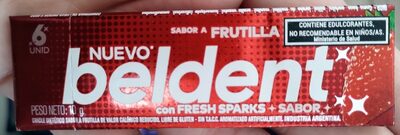Beldent sabor Frutilla - 10 g
This product page is not complete. You can help to complete it by editing it and adding more data from the photos we have, or by taking more photos using the app for Android or iPhone/iPad. Thank you!
×
Barcode: 77969118
Common name: chicle dietético sabor frutilla de valor calórico reducido, libre de gluten.
Quantity: 10 g
Packaging:
Composite material, Bag, Box, Individual bag, Paper and cardboard / Plastic / Aluminium, 84 C/PAP
Brands: Beldent
Categories: Snacks, Sweet snacks, Confectioneries, Specific products, Products for specific diets, Products without gluten, Chewing gum, Sugar-free chewing gum
Labels, certifications, awards:
No gluten, Sistema de Etiquetado Frontal de Alimentos y Bebidas, Contiene edulcorantes no recomendable en niños, es:Sin TACC, es:Aromas artificiales

Origin of ingredients: Argentina
Manufacturing or processing places: Buenos Aires, Argentina
Traceability code: RNE 020000604, IM SRA 6828/1564, RE 800222091/2, RSPA 46155, 040503090001
Link to the product page on the official site of the producer: https://www.mondelezinternational.com/
Matching with your preferences
Health
Ingredients
Food processing
Additives
Ingredients analysis
Nutrition
Environment
Packaging
Transportation
Report a problem
Data sources
Product added on by foodvisor
Last edit of product page on by 5m4u9.
Product page also edited by fernandoazul231, foodless, vegetarian-app-chakib.




